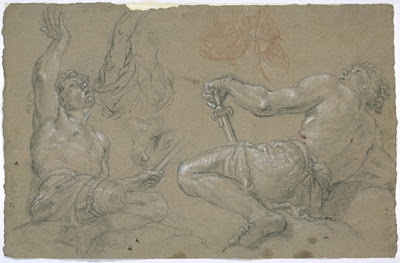 |
| Pierre Mignard Drapery Study for Portrait of Daniel Voysin ca. 1668 drawing Musée du Louvre |
 |
| Pierre Mignard Head Studies for Allegorical Figure of Faith ca. 1692 drawing Musée du Louvre |
 |
| Pierre Mignard Studies of Seated Figure ca. 1650 drawing Musée du Louvre |
 |
| Pierre Mignard Study of Half-Length Figure before 1695 drawing Musée du Louvre |
 |
| Pierre Mignard Study of Half-Length Figure ca. 1650 drawing Musée du Louvre |
 |
| Pierre Mignard Studies for the Prophets Jonah and Jeremiah before 1695 drawing Musée du Louvre |
 |
| Pierre Mignard Ornamental Figures for Thesis Frontispiece ca. 1692 drawing Musée du Louvre |
 |
| Pierre Mignard Sheet of Studies before 1695 drawing Musée du Louvre |
 |
| Pierre Mignard Sheet of Studies before 1695 drawing Musée du Louvre |
 |
| Pierre Mignard Sheet of Studies before 1695 drawing Musée du Louvre |
 |
| Pierre Mignard Sheet of Studies before 1695 drawing Musée du Louvre |
 |
| Pierre Mignard Sheet of Studies before 1695 drawing Musée du Louvre |
 |
| Pierre Mignard Studies of Painter's Hands for St Luke painting the Virgin ca. 1695 drawing Musée du Louvre |
 |
| Pierre Mignard Studies of Soldiers' Hands for The Taking of Christ ca. 1690 drawing Musée du Louvre |
 |
| Pierre Mignard Studies of Gesturing Forearm before 1695 drawing Musée du Louvre |
 |
| Pierre Mignard Studies of Legs in Clouds before 1695 drawing Musée du Louvre |
 |
| Pierre Mignard Studies of Legs in Clouds before 1695 drawing Musée du Louvre |
 |
| Pierre Mignard Studies of Hand with Pen before 1695 drawing (on scrap sheet with letterpress) Musée du Louvre |
Pierre Mignard – French painter, the chief rival of Lebrun, whom he succeeded in 1690 as First Painter to the King and Director of the Academy. Having studied for some time in Paris under Vouet, Mignard lived in Rome, 1636-57, visiting Venice and other north Italian towns in 1654. His style was formed on Annibale Carracci, Domenichino and Poussin, although he pretended allegiance with the Venetian colourists in the quarrel between the Poussinistes and the Rubénistes, mainly to oppose Lebrun. In 1657 he was summoned back to France by Louis XIV, achieving success in the decoration of private houses and churches, but mainly as a portraitist, the only field in which he showed any originality, giving life to the tired tradition of the Portrait historié.
– Erika Langmuir and Norbert Lynton, Yale Dictionary of Art and Artists (2000)